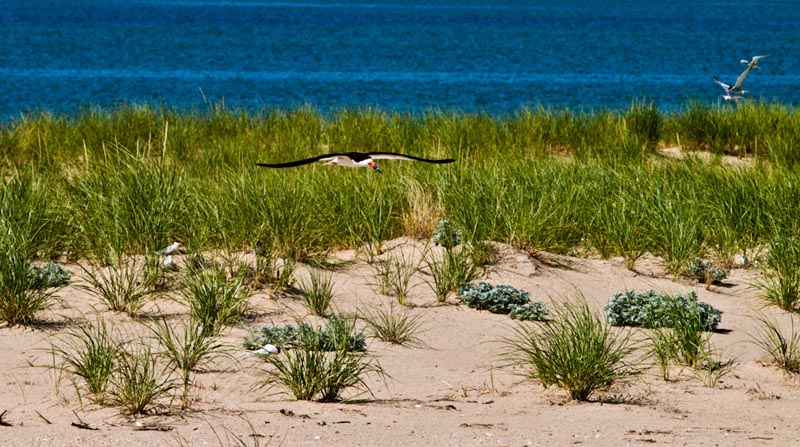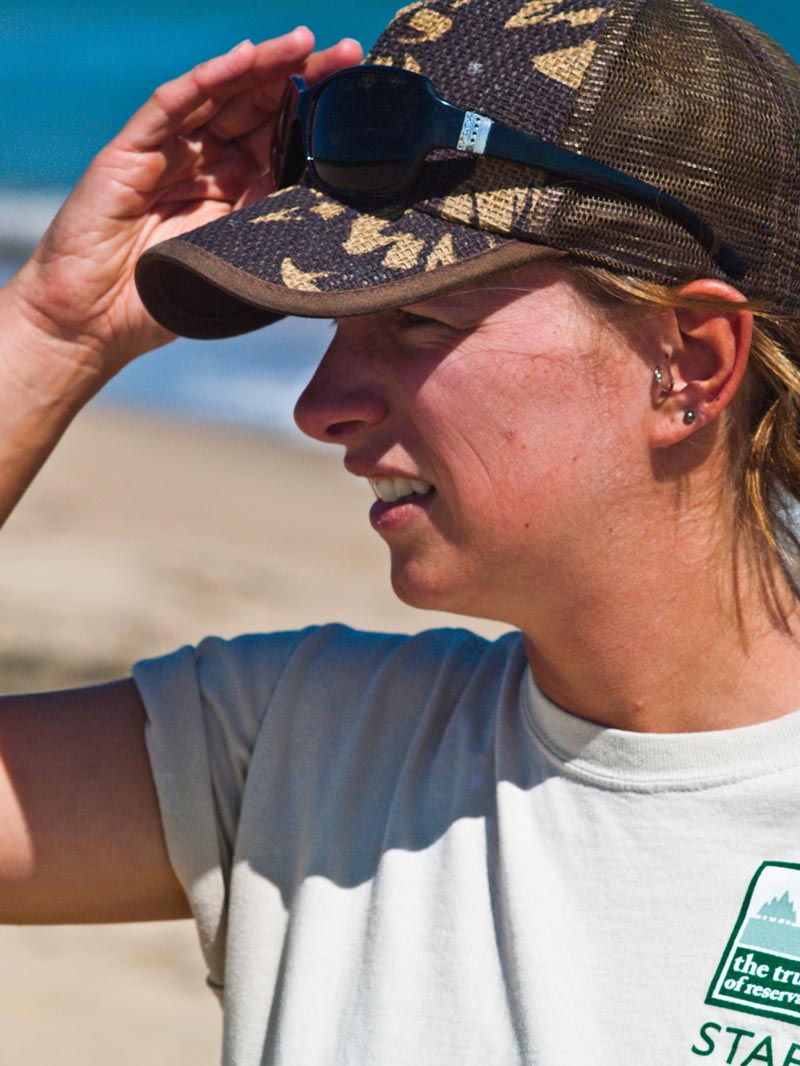A bird not usually seen in Massachusetts — and very rarely on the Vineyard — has nested successfully for the first time among this year’s highly productive tern colony at Norton Point.
Four breeding pairs of black skimmers have made themselves at home at Norton Point beach among the hundreds of least terns and common terns nesting this year. So far, three black skimmer pairs are parents to healthy chicks, with one pair still incubating, said Kelly Peebles, a shorebird monitor for The Trustees of Reservations. The first black skimmers arrived on the beach in early June.
The red and black bill of the skimmer sets it apart from many other birds, with the lower mandible longer than the upper. The black skimmer received its name from its particular style of foraging — its lower bill skims the water as the bird flies along the ocean; when it catches a fish, the upper bill clamps down.

Brian Degasperis, a coastal ecologist for The Trustees of Reservations, said black skimmers typically breed along the Atlantic coast from Massachusetts to Florida.
“Since Massachusetts is at the northern end of the breeding range for skimmers, they are an unusual and welcomed sight on our beach,” he said.
Mr. Degasperis said the total number of breeding pairs in Massachusetts has ranged from only zero to seven each year since 1985, making the four pairs at Norton Point a significant number statewide and a record for Norton Point itself.
On Wednesday afternoon, Norton Point beach was bustling with bird activity, with hundred of terns flying overhead and others socializing near their nests. Between 600 and 700 least tern pairs and around 200 common tern pairs have also nested on Norton Point. Although there are only a handful of them, the adult skimmers’ sleek black wings and bright red beaks pop out in the crowd of white and grey terns.
“The skimmers started nesting right in the middle of the tern colony,” Ms. Peebles said. “They’re hard to miss. They look like toucans on the sand.”
The two to three-week-old black skimmer chicks are still grey and fluffy, but their legs are lanky as they toddle around the dunes.
The first chick was sighted during the first week of July. Ms. Peebles said she has sighted as many as nine chicks in one day at Norton Point.
“But they were all running around,” she said. “And that was a couple of weeks ago, so the number could be higher or lower.”
Fellow shorebird monitor Emily Aldrich spotted one of the black skimmer chicks as she peered through binoculars. “They’re growing up so fast!” she said.
“They’re in their awkward teenage phase now,” added Ms. Peebles. “Kind of gangly and disproportioned.”
For now, the two mandibles of the chicks’ beaks are equal in length, but at about four weeks, the lower mandible will be one centimeter longer than the upper.
The chicks have not yet fledged; it takes three to four weeks before chicks are able to feed themselves and fly, said Mr. Degasperis.
“The older and bigger the chicks are, the more capable they are at avoiding predators and weathering destructive storms,” he said. “We are hoping that this will be the first productive and successful year for black skimmers at Norton Point.”
The black skimmers have tried breeding on Norton Point before. According to the Trustees of Reservations shorebird monitoring records, one pair of black skimmers first came to Norton Point in 2009, but Hurricane Bill wiped out their nest in August. In 2010 two pairs tried to get cozy, but lost their nests to predation. And last year even the typical tern colony did not settle, as a preying bird came through the area and disturbed the terns to the point where they abandoned their site.
Norton Point serves as an ideal habitat for black skimmers, terns and other shorebirds because it is a large expanse of open sand surrounded by water on either side — Katama Bay and the Atlantic Ocean. The pockets of dune grass and vegetation make the habitat all the more pleasing for those breeding and nesting.
Mr. Degasperis said, typically, terns and black skimmers prefer living on sand islands just off the coast. Because some of these islands will get washed away by tides and others taken over by sea gulls, the skimmers inhabit places like Norton Point which provide some degree of shelter.
“If we didn’t give them any protection or define areas to set up that wouldn’t be disturbed by human recreational activities, it’s less likely that they would be present,” said Mr. Degasperis.







Comments
Comment policy »